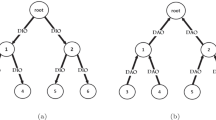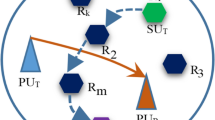Abstract
The study on the topic has an intention of increasing energy life increases with the possible logics like optimized double Q-learning, application of intellectual cognitive radio network system and the entrenched Internet of Things on the Network Lifetime Aware Routing Protocol (NLARP). A system has been developed using such an algorithm, the study has covered the problem of overestimation in the Q-learning, and the solution by double Q-learning has been recorded. Spectrum and energy conservation or enhancement was another logic where the battery usage of 50% has been studied and found that the energy has been saved or better utilized. The study concludes that the chosen technology has reflected very positively in all aspects.
Access this chapter
Tax calculation will be finalised at checkout
Purchases are for personal use only
Similar content being viewed by others
References
Bindhu V (2020) Constraints mitigation in cognitive radio networks using computing. J Trends Comput Sci Smart Technol 2(1):1–10
Gu Y, Chen H, Zhai C, Li Y, Vucetic B (2019) Minimizing age of information in cognitive radio-based IoT systems: underlay or overlay? IEEE Internet Things J 6:10273–10288
Azade Fotouhi MD (2021) Deep Q-learning for two-hop communications of drone base station. J Sens 21(6)1–14
Albaire NB (2021) Cognitive radio based internet of things: applications, challenges and future research aspects. Int J Eng Inf Syst 5(5):58–62
Wenli Ning XH (2020) Reinforcement learning enabled cooperative spectrum sensing in cognigive radio networks. J Commun Networks 22(1):12–21
Koushik AF (2019) Intelligent spectrum management based on transfer actor-critic learning for rateless transmissions in cognitive radio networks. J IEEE 1–11
Upadhye A, Saravanan P (19 June 2021) A survey on machine learning algorithms for applications in cognitive radio networks, ar**v:2106.10413v1 [eess.SP]
Macro Lombardi FP (2021) Internet of Things: a general overview between architectures, protocols and applications. J Inf 12(2):12–87
Thuslimbanu DK (2014) Spectrum holes sensing policy for cognitive radio network spectrum holes sensing policy for cognitive radio network. Int J Adv Res Comput Sci Technol 2(1):170–175
Zhou JS (2020) Dependable scheduling for real-time workflows on cyber-physical cloud systems. IEEE Trans Ind Inf 109(1):1–10
Sharma DK (2018) A machine learning based protocol for efficient routing in opportunistic networks. IEEE Syst J 12(3):2207–2213
Jiang T (2011) Reinforcement learning-based spectrum sharing for cognitive radio. New York, Department of Electronics University of York
Zhang WZ (2018) Satellite mobile edge computing: improving QoS of high-speed satellite terrestrial networks using edge computing techniques. IEEE Network 97(c):70–76
https://www.gsma.com/iot/wp-content/uploads/2014/08/cl_iot_wp_07_14.pdf. Accessed 13 April 2022
Djamel Sadok CM (2019) An IOT sensor and scenario survey for data researchers. J Braz Comput Soc 25(4):2–17
Zikira HY (2020) Cognitive radio networks for internet of things and wirless sensor network. J Sens 20(5288):1–6
Liu XM (2021) Movement based solutions to energy limitation in wireless sensor networks: state of the art and future trends. IEEE Networks 9(1):188–193
Nilsson E, Anderson D (2018) Internet of things a survey about thoughts and knowledge. National Category Engineering and Technology
Wu Z (2020) Scheduling-guided automatic processing of massive hyperspectral image classification on cloud computing architectures. IEEE Trans Cybern 51(7):1–14
Marchese M, Patrone F (2018) Energy-aware routing algorithm for DTN-nanosatellite networks. In: Proceedings of IEEE global communications conference, Abu Dhabi
Zhao YM (2020) On hardware trojan-assisted power budgeting system attack targeting many core systems. J Syst Archit 109(10):1–11
Zhang WG (2017) IRPL: an energy efficient routing protocol for wireless sensor networks. J Syst Archit 11(3):35–49
Vimal Shanmuganathan LK (2021) EECCRN: energy enhancement with CSS approach using Q-learning and coalition game modelling in CRN. Inf Technol Control 50(1)
Suresh P (2014) A state of the art review on the internet of things (IoT) history, technology and fields of deployment. In: 2014 International conference on science engineering and management research (ICSEMR), pp 1–8
Jyoti Sharma SK (2020) Hybrid firefly optimization with double Q-learning for energy enhancement in cognitive radio networks. Int J Eng Res Technol 7(3):5227–5232
Deng XH (2020) Task allocation algorithm and optimization model on edge collaboration. J Syst Archit 110:1–14
Sun YZ (2019) An efficient and scalable framework for processing remotely sensed big data in cloud computing environments. IEEE Trans Geosci Remote Sens 4294–4308
Author information
Authors and Affiliations
Corresponding author
Editor information
Editors and Affiliations
Rights and permissions
Copyright information
© 2023 The Author(s), under exclusive license to Springer Nature Singapore Pte Ltd.
About this paper
Cite this paper
Sharma, J., Patel, S.K., Patle, V.K. (2023). A Study on the Implications of NLARP to Optimize Double Q-Learning for Energy Enhancement in Cognitive Radio Networks with IoT Scenario. In: Yadav, R.P., Nanda, S.J., Rana, P.S., Lim, MH. (eds) Proceedings of the International Conference on Paradigms of Computing, Communication and Data Sciences. Algorithms for Intelligent Systems. Springer, Singapore. https://doi.org/10.1007/978-981-19-8742-7_34
Download citation
DOI: https://doi.org/10.1007/978-981-19-8742-7_34
Published:
Publisher Name: Springer, Singapore
Print ISBN: 978-981-19-8741-0
Online ISBN: 978-981-19-8742-7
eBook Packages: Intelligent Technologies and RoboticsIntelligent Technologies and Robotics (R0)




